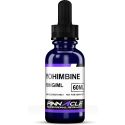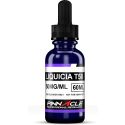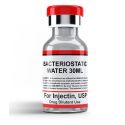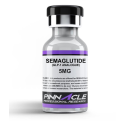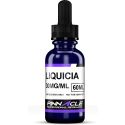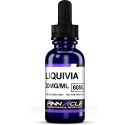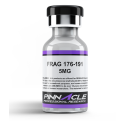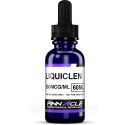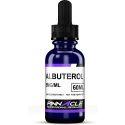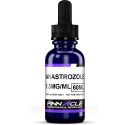How to Properly Store Peptides: Handling & Storage Guidelines
This website's contents, articles and product information are all provided purely for educational and informational purposes. The products that are offered on this platform are only meant to be used in in vitro research. The word "in vitro," which comes from the Latin "in glass," describes research that is done outside of a living creature. It is important to remember that these products are not pharmaceuticals or medicines, and the FDA has not approved them for use in the diagnosis, treatment, or prevention of any illnesses or disorders. It is legally forbidden for these goods to be ingested by humans or animals.
As a researcher or scientist working with peptides, you understand the immense value and potential of these remarkable biomolecules. From drug development to biochemical studies, peptides play a significant role in revealing the mysteries of life. However, they are very fragile biomolecules that require careful handling and storage protocols for their preservation and efficacy. In this comprehensive guide, we'll explore the intricate world of peptide storage, and learn secrets behind maintaining these invaluable samples for dependable research outcomes.
Understanding Peptides: The Delicate Wonders
Before looking into the guidelines for storing peptides properly, it is important to understand what they are.
Amino acid chains linked by peptide bonds are called peptides. These amazing macromolecules are the building blocks of proteins and are involved in many biological functions, including immunological response, cell signaling, and enzyme catalysis. Their biochemical activity requires complex folding patterns, which give rise to their distinct three-dimensional structures.
The consequences of improper peptide storage can have severe outcomes, causing structural modifications, reduced efficacy, and even potential threats. Peptides are likely to degrade when their delicate folding patterns get disrupted, thereby making them less effective or potentially dangerous. This highlights the need for vigilance in observing protocols to maintain data integrity and reliability during the study.

Temperature: The Frigid Frontier
Temperature is one of the major determinants in terms of maintaining the stability of peptides. Peptides can be as delicate as snowflakes because they keep their proper secondary structures in the cold, but they just disintegrate and melt with heat.
Refrigerated Storage Guidelines
The majority of peptides should be stored in a refrigerator between 2°C and 8°C (35°F and 46°F) [1]. The structural integrity of the peptides is preserved and degradation is impeded by this low, stable temperature range. Peptide destabilizing chemical processes are slowed down and the chance of microbial development, which might further impair sample quality, is reduced by refrigeration.
Frozen Storage Considerations
If you wish to store peptides for an extended amount of time, usually longer than six months then Freezing at -20°C (-4°F) or lower is suitable [2]. However, it is important to be cautious with repeated freeze-thaw cycles, as the delicate peptide structure may be damaged by the ice crystals that form. Consider dividing your peptide samples into smaller amounts before freezing them to reduce this danger and only melt the amount needed for each experiment.
Light: The Vampiric Enemies
Peptides are extremely vulnerable to the harmful effects of light exposure, especially ultraviolet (UV) radiation, much as vampires are afraid of sunlight.
Photodegradation: The Silent Peptide Killer
Photodegradation is a phenomena where UV rays cause chemical reactions and disrupt sensitive links within peptide structures. The peptides' folding patterns may be changed by this silent killer, making them less useful or even dangerous.
Opaque or Amber Vial Storage
Always store your peptides in opaque or amber vials or containers to protect them from the harmful effects of light exposure [3]. These particular containers are made to prevent damaging UV rays from destroying your precious samples. Think about the vials' ability to block light and suitability for your particular peptide samples while choosing them.
Working Under Subdued Lighting Conditions
It is essential to minimize light exposure even during handling and reconstitution procedures. Avoid bright fluorescent lab lights that can cause peptide breakdown before your tests have even started, and instead work in areas with poor lighting. [4].
Dryness: The Desert Oasis
Despite being necessary for life, water can be a powerful opponent when it comes to storing peptides. Moisture may accelerate degradation by causing water molecules to disrupt the fragile peptide bonds in a process known as hydrolysis.
Peptides as Lyophilized Solids
Peptides are usually delivered as lyophilized (freeze-dried) solids to avoid the moisture hazards. Through this procedure, the majority of the water content is eliminated, leaving behind a stable, dry powder that doesn't significantly deteriorate over extended storage times.
Long-term Storage with Desiccant Packs
For long-term storage, it's crucial to keep your lyophilized peptide vials tightly sealed and include a desiccant pack. These small packets absorb any residual moisture, creating a dry environment that minimizes the risk of hydrolysis and preserves the peptides' structural integrity.
Reconstituted Peptide Solutions
Peptides are subject to increased hydrolysis susceptibility after being reconstituted in solution. To reduce this risk, use the reconstituted peptide as soon as possible, or think about aliquoting it into smaller portions for later usage. [5]. By reducing the amount of times the peptide solution is exposed to moisture, this method extends its stability and efficacy.
Containers: The Right Fit
Selecting the right containers for your peptide samples is essential to avoid contamination, leaching, and adsorption.
The Challenge of Surface Binding
Peptides have a tendency to "stick" or attach to glass and some plastic surfaces, which lowers your solution's effective concentration. Surface binding, also referred to as adsorption, is a phenomena that can jeopardize the precision and repeatability of your research.
Low-binding Vials and Siliconized Tubes
Use low-binding vials or tubes made especially to reduce peptide adsorption to get around this problem. Since polypropylene containers have lower affinity for binding peptides, they are frequently advised [6]. Siliconized tubes can also lessen surface contacts even further, guaranteeing that your peptide samples maintain the appropriate concentration.
Plastic Compatibility Considerations
In terms of peptide storage, not all polymers are made equal. Over time, certain plastics may react or contaminate your peptide samples with chemicals or substances that leach out of them. To preserve sample integrity, find out more about the materials used to make your chosen containers and think about changing them on a regular basis.
Best Practices and Top Tips
Here are some more best practices and important pointers to guarantee the greatest possible preservation of your peptide samples:
- Labeling and Organization: Give your peptide vials legible labels that clearly display the peptide name, concentration, and expiration date. You can track and manage your samples more successfully if you are organized.
- Handling and Reconstitution Procedures: Develop and stick to defined methods for processing and reconstituted peptide samples. In order to reduce variability and guarantee repeatable results, consistency is essential.
- Record-keeping and Documentation: Keep thorough records of your handling techniques, peptide storage conditions, and any alterations or degradation that you notice. For troubleshooting and spotting any problems, this documentation might be quite helpful.
- Temperature Monitoring: Invest in reliable temperature monitoring systems for your refrigerators, freezers, and storage units. Regular calibration and maintenance will ensure consistent temperature control.
- Training and Education: Be sure that everyone handling and storing peptides has received the appropriate education and training on relevant guidelines and best practices.
- Source High-Quality Peptides: For optimal research outcomes, source your peptides from a reputable supplier like Pinnacle Peptides. They offer a wide range of high-purity, research-grade peptides backed by rigorous quality control and testing. Explore the catalog and buy research peptides conveniently online.
You can reduce the probability of peptide degradation and guarantee the reliability and consistency of your research projects by following these recommendations and putting strong storage procedures in place.
Frequently Asked Questions (FAQs)
1. How long can peptides be stored if properly refrigerated or frozen?
The storage life of peptides can vary depending on the specific peptide and storage conditions. Generally, peptides stored at 2°C to 8°C can retain their stability for several months to a year or more. For frozen storage at -20°C or lower, peptides can often remain stable for multiple years when properly handled and stored.
2. Can peptides be shipped at room temperature?
While it's generally recommended to ship peptides under refrigerated or frozen conditions, some peptides may be stable enough for short-term room temperature shipping. However, this depends on the specific peptide and the duration of transport. Always consult the manufacturer's guidelines or conduct stability studies to ensure the integrity of your peptide samples during shipping.
3. Can I reuse the same vial or container for different peptide samples?
It's generally not advisable to reuse the same vial or container for different peptide samples, as cross-contamination can occur. Even trace amounts of residual peptides or solvents from previous samples can potentially interact with or degrade your new sample. Always use fresh, clean containers to ensure the purity and integrity of your peptide samples.
4. How can I determine if my peptide has degraded during storage?
There are several indicators that your peptide may have degraded during storage, including visible changes in appearance (e.g., discoloration, precipitation), altered solubility or stability in solution, and diminished biological activity or potency. Analytical techniques like mass spectrometry, chromatography, and spectroscopic methods can also be employed to assess peptide integrity and detect degradation products.
5. Can I store reconstituted peptide solutions for later use?
While it's preferable to use reconstituted peptide solutions promptly, it is possible to store them for later use in certain cases. However, this should be done with caution and appropriate precautions. Consider aliquoting the reconstituted solution into smaller portions and storing them at the recommended temperatures (typically -20°C or lower) to minimize repeated freeze-thaw cycles and exposure to moisture.
6. How long does a vial of peptides last?
Unopened, lyophilized peptide vials can last for months to years when stored properly at recommended refrigerated or frozen temperatures with desiccants.
7. How long are peptides stable in solution?
The stability of peptides in solution can vary, but they generally degrade faster than lyophilized forms due to hydrolysis. Aim to use reconstituted solutions promptly.
8. Do peptides expire in the fridge?
Yes, peptides stored in the refrigerator (2°C to 8°C) can eventually expire or degrade over several months to a year, depending on the specific peptide.
9. Do peptides degrade over time?
Yes, all peptides will gradually degrade over time, even when stored properly. Proper storage conditions simply slow down the degradation process.
10. How long do peptides last once reconstituted?
The shelf life of reconstituted peptides can range from hours to days or weeks, depending on the peptide and storage conditions. Prompt use or aliquoting with frozen storage is recommended.
11. How long are peptides stable in water?
Peptides are generally not very stable in aqueous solutions due to hydrolysis. They have a limited shelf life ranging from hours to a few days when reconstituted in water.
Conclusion
Preserving the integrity and potency of peptide samples is a critical aspect of ensuring reliable and reproducible research outcomes. By adhering to the comprehensive guidelines outlined in this article, you can navigate the intricate world of peptide storage with confidence, minimizing the risks of degradation and maximizing the longevity of your precious samples.
Remember, temperature control, light protection, moisture removal, and the selection of appropriate containers are the cornerstones of optimal peptide storage. Implement robust protocols, maintain detailed records, and stay vigilant in your storage practices to safeguard the delicate folding patterns and biological activity of these remarkable biomolecules.
Ultimately, proper peptide storage is not just a best practice; it's a fundamental requirement for maintaining the integrity of your work and advancing scientific discovery. Treat your peptide samples with the utmost care and diligence, and they will reward you with consistent, reliable results that unlock the secrets of life's intricate mechanisms.
Referenced Citations
- Apostolopoulos, V., Bojarska, J., Chai, T. T., Elnagdy, S., Kaczmarek, K., Matsoukas, J., ... & Martinez-Hackert, E. (2021). A global review on short peptides: Frontiers and perspectives. Molecules, 26(2), 430.
- Dill, K. A., Ozcan, S. S., Shell, M. S., & Weikl, T. R. (2008). The protein folding problem. Annual Review of Biophysics, 37, 289-316.
- Patel, M. B., Patel, J. K., & Patel, M. M. (2017). Lyophilization/freeze-drying: A review. International Journal of Pharmaceutical Sciences and Nanotechnology, 10(3), 4026-4041.
- Vallejo-Castillo, J., Escobedo, R. M., Castellanos-Cruz, N., & Sanchez-Salas, R. (2020). Photodegradation of biological molecules: A review on the principles and applications of photostability assays. Biomolecules, 10(9), 1271.
- Temussi, P. A. (2019). Peptide Handling and Storage. Cold Spring Harbor Protocols, 2019(12).
- Wang, W. (1999). Instability, stabilization, and formulation of liquid protein pharmaceuticals. International Journal of Pharmaceutics, 185(2), 129-188.



